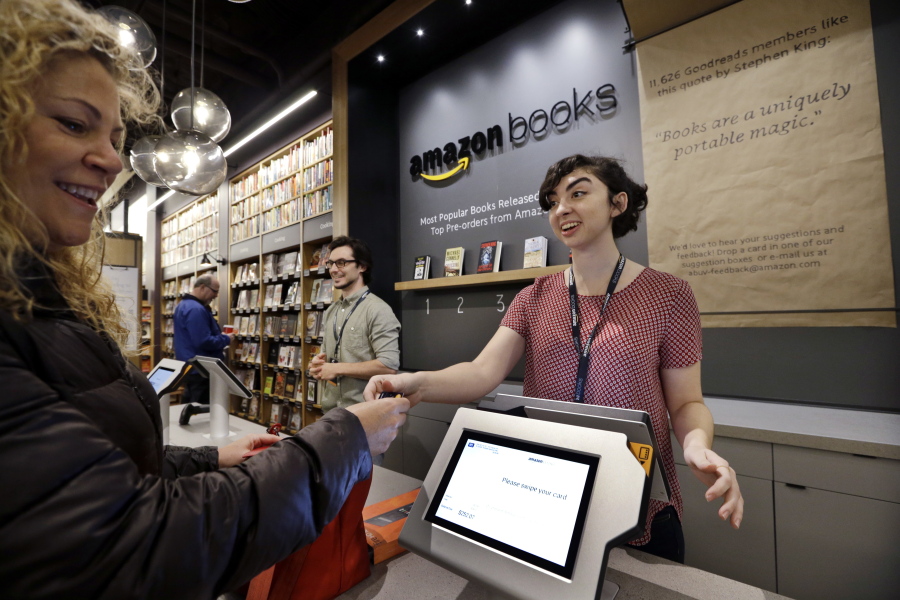NEW YORK — Is the online giant of retail also looking to conquer physical stores?
Amazon has been dabbling in physical retail since 2015, during which time it’s opened a half-dozen bookstores that double as gadget emporia, a score of campus bookstores that don’t sell books and a convenience store without cashiers. For now, its efforts seem largely experimental, though that may not be true for long.
Although the company already dominates e-commerce, 90 percent of worldwide retail spending is still in brick-and-mortar stores, according to eMarketer. Amazon has the chance to change retail with automation and data-mining technologies borrowed from e-commerce.
“It seems counterintuitive they are investing in any physical stores when they are blamed for the demise of so many of them, but no cow is sacred,” said Sucharita Mulpuru, a retail analyst in Charlotte, N.C.
Amazon’s offline ambitions could even boost Amazon’s online operations further, even though they seem to be doing just fine for now. In the first three months of the year, the Seattle company earned $724 million, or $1.48 per share, a 41 percent increase from a year earlier. Amazon soundly beat Wall Street’s expectations of $1.08 per share, according to FactSet. Revenue increased 23 percent to $35.7 billion, above expectations of $35.3 billion.
Amazon doesn’t break out numbers for its retail store operations. Chief Financial Officer Brian T. Olsavsky said in February that “we’re still in that phase where we’re testing and learning and getting better.” Exactly what it’s learning, and what it plans to do with that knowledge, is the next big question.
Here are five ways physical stores could help Amazon.
Showcase for gadgets
At Amazon’s six physical bookstores — six more are on the way — books are arranged on shelves face out, even though that takes more space. Amazon isn’t trying to cram its entire inventory into these stores; Amazon figures you can just order everything else from your phone.
Amazon also devotes a lot of space to its Kindle e-readers, streaming TV devices and other gadgets, so you can try them out before buying. Tutorials are also offered on weekends.
Wedbush Securities analyst Michael Pachter said physical bookstores are good places to win Kindle converts, as “the only people who don’t have Kindles who should have Kindles are Luddites who also read.”
Serendipity
Amazon opened its third bookstore in October, near Portland. Miriam Sontz, CEO of Powell’s Books in Portland, calls Amazon’s entry “an acknowledgement of the inability of the internet to provide a certain retail experience that book buyers enjoy.” That includes spontaneous conversations with fellow shoppers on what they’re reading, and having a book cover or blurb grab you as you walk down the aisle.
Robert Hutu, a retail analyst at Gartner, said online customers tend to go to a website knowing what they want to buy. By contrast, customers visiting a physical store often make impulse purchases, even if they go in with something specific in mind. Amazon could learn more about that serendipity from its stores, and perhaps find better ways to increase impulse buying online, Hutu said.
Make customers work
Amazon is scheduled to open its 20th bookless campus bookstore next week in Cleveland. Students order textbooks and dorm furnishings online and come to these stores to pick them up. The centralized pickup location reduces shipping expenses.
The company is also testing a grocery pickup service at two locations in Seattle. Once it launches, Prime members will be able to order groceries online and visit one of these stores for pickup, skipping the aisles. Crews will even bring orders to the car. It’s cheaper than door-to-door deliveries.
Retail technology
Amazon already makes heavy use of robots at warehouses to fulfill online orders. Now Amazon is trying to bring automation to retail. The Amazon Go convenience store in Seattle uses sensors to track items as shoppers put them into baskets or return them to the shelf. The shopper’s Amazon account gets automatically charged. The store is expected to open to the public soon, after a test with Amazon employees.
Amazon could use the data to manage inventory and assess when to discount items, Mulpuru said.
Building loyalty
Amazon can use its campus locations to promote its Prime loyalty program (students get 50 percent off). The strategy is simple: Get students hooked, and they’ll be customers for life.
As for the regular bookstores, Prime members get the same prices as available online.



